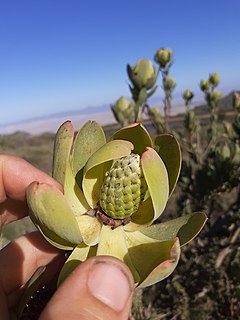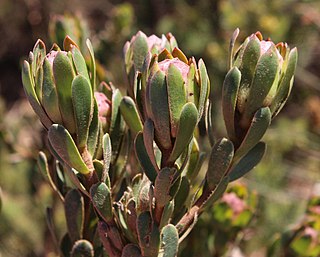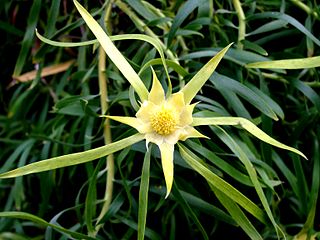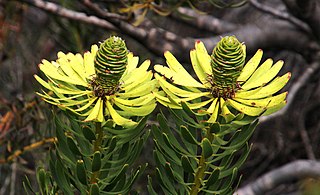
Leucadendron linifolium, the line-leaf conebush, is a flower-bearing shrub that belongs to the genus Leucadendron and forms part of the fynbos. The plant is native to the Western Cape, where it occurs in the Cape Flats from Eerste River to the Strand, Bot River to Elim and Bredasdorp, Potberg and Jakkalsfontein to Riversdal Plains. The shrub grows 2 m tall and bears flowers in September to October.
Leucadendron burchellii, the Riviersonderend conebush, is a flower-bearing shrub that belongs to the genus Leucadendron and forms part of the fynbos. The plant is native to the Western Cape where it occurs in the Riviersonderend Mountains from Jonaskop to McGregor.
Leucadendron cinereum, the scraggly conebush, is a flower-bearing shrub that belongs to the genus Leucadendron and forms part of the fynbos. The plant is native to the Western Cape where it occurs from Hopefield and on the Cape Flats from the Berg River estuary to Kraaifontein.

Leucadendron concavum, the Pakhuis conebush , is a flower-bearing shrub that belongs to the genus Leucadendron and forms part of the fynbos. The plant is native to the Western Cape where it occurs at the Pakhuis Pass in the Cederberg.

Leucadendron diemontianum, the Visgat conebush, is a flower-bearing shrub belonging to the genus Leucadendron and forms part of the fynbos. The plant is native to the Western Cape where it occurs on the foothills of the Great Winterhoek Mountains at Visgat, Onderboskloof and Rosendal as well as at Heuningvlei in the northern Cederberg.

Leucadendron dregei, the summit conebush, is a flower-bearing shrub belonging to the genus Leucadendron and forms part of the fynbos. The plant is native to the Western Cape and occurs in the Swartberg from Touwsberg to Meiringspoort. The shrub grows up to 0.6 m tall and flowers from November to December.

Leucadendron sorocephalodes, the woolly conebush, is a flower-bearing shrub belonging to the genus Leucadendron and forms part of the fynbos. The plant is native to the Western Cape and Eastern Cape where it occurs from the Outeniqua Mountains to the Baviaanskloof Mountains.

Leucadendron stelligerum, the Agulhas conebush, is a flower-bearing shrub that belongs to the genus Leucadendron and forms part of the fynbos. The plant is native to the Western Cape where it occurs from Elim to the Agulhas Plain.

Leucadendron nitidum, the Bokkeveld conebush, is a flower-bearing shrub that belongs to the genus Leucadendron and forms part of the fynbos. The plant is native to the Western Cape where it occurs at Cederberg, Koue Bokkeveld and Swartruggensberge.

Leucadendron procerum, the ivory conebush, is a flower-bearing shrub that belongs to the genus Leucadendron and forms part of the fynbos. The plant is native to the Western Cape where it occurs on the Bokkeveld Carp, Gifberg, Cederberg to the Olifants River Mountains and the northern Sandveld.

Leucadendron rubrum, the spinning top, is a flower-bearing shrub belonging to the genus Leucadendron and forms part of the fynbos. The plant is native to the Western Cape, where it occurs in the Bokkeveld, Gifberg, Cederberg to the Hottentots-Holland Mountains and Riviersonderend Mountains, Touwsberg, Rooiberg, Kammanassie Mountains, Piketberg, Table Mountain and the Cape Flats. The shrub grows 2.5 m tall and flowers from August to September.

Leucadendron floridum, the flats conebush, is a flower-bearing shrub belonging to the genus Leucadendron and forms part of the fynbos. The plant is native to the Western Cape, where it occurs in the Cape Flats, from Rondebosch to Kuils River and also in the Cape Peninsula around most wetlands. The shrub grows 2 m tall and bears flowers from September to October.

Leucadendron eucalyptifolium, the gum-leaved conebush, is a flower-bearing shrub belonging to the genus Leucadendron and forms part of the fynbos. The plant is native to the Western Cape and the Eastern Cape, where it occurs in the Potberg, Riversdal Plains, Langeberg, Outeniqua Mountains, Tsitsikamma Mountains, Kouga Mountains, Elandsberg, Swartberg, Waboomsberg, Warmwaterberg, Touwsberg, Rooiberg and Soetwaterberg. The shrub grows 4 m tall and bears flowers from July to October.

Leucadendron teretifolium, the needle-leaf conebush, is a flower-bearing shrub belonging to the genus Leucadendron and forms part of the fynbos. The plant is native to the Western Cape, where it occurs on the Elimvlakte, Kleinrivierberge, Riviersonderendberge, Potberg, Bonteberg, Witteberg, Waboomsberg and Langeberg. The shrub grows 1.0 m tall and bears flowers from August to September.
Leucadendron tradouwense, the Tradouw conebush, is a flower-bearing shrub belonging to the genus Leucadendron and forms part of the fynbos. The plant is native to the Western Cape, where it occurs in the Langeberg Range at the Tradouw Pass and Groot Vadersbos. The plant is rare, there are only two known populations.
Leucadendron foedum, the Hopefield conebush, is a flower-bearing shrub belonging to the genus Leucadendron and forms part of the fynbos. The plant is native to the Western Cape, South Africa, and occurs from Piketberg to Hopefield.

Leucadendron pubescens, the grey conebush, is a flower-bearing shrub belonging to the genus Leucadendron and forms part of the fynbos. The plant is native to the Western Cape where it occurs on the Bokkeveldeskarp, Gifberg, Cederberg, Piketberg, Olifantsrivier, Sandveld, Koue Bokkeveld, Hexrivierberge, Bonteberg as well as the Kwadouwberg, Witteberg and Touwsberg.

Leucadendron globosum, the Grabouw conebush, is a flower-bearing shrub belonging to the genus Leucadendron and forms part of the fynbos. The plant is native to the Western Cape where it occurs from Grabouw to Houhoek in the Elgin Valley.

Leucadendron platyspermum, the plate-seed conebush, is a flower-bearing shrub belonging to the genus Leucadendron and forms part of the fynbos. The plant is native to the Western Cape where it occurs from the Donkerhoekberg near Villiersdorp, Groenlandberg and Kleinmondberge from Houhoek to the Elimvlakte.

Leucadendron meridianum, the limestone conebush, is a flower-bearing shrub belonging to the genus Leucadendron and forms part of the fynbos. The plant is native to the Western Cape, South Africa.





















